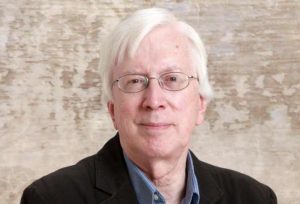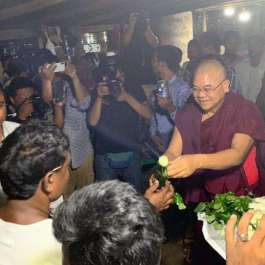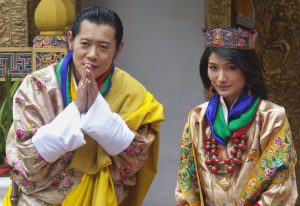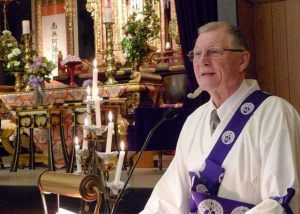
Mahabhikksu Ashin Jinnarakkhita is, without question, the most important figure in post-independence Indonesian Buddhism. Although Indonesia is a predominantly Muslim country, prior to the arrival of Islam in the 13th Century the archipelago that today makes up Indonesia was majority Buddhist. However, by the time of Independence in 1945, Buddhism was mostly confined to immigrant Chinese communities and a few isolated indigenous hold-out communities from the Buddhist era. Jinnarakkhita is universally recognized today as being responsible for the revival of Indonesian Buddhism that took place in the 1950s and 1960s, even by Indonesian Buddhist organizations that do not trace their origins to him.*
Indonesian Buddhism today is shaped as much by Jinnarakkhita’s successes as by his failures. His life’s work was colored by two visions that made his propagation of the Dharma in Indonesia unique: that of the “Indonesianization” of Buddhism and of the organizational unity of the Buddhist community in Indonesia. Here, I would like to keep the biographical details of this great monk to the minimum required for context, as they are readily available online in English. Instead, I would like to paint a picture of the development of modern Indonesian Buddhism by describing the success of his first vision and the failure of the second.
Jinnarakkhita was born Tee Boan An in Bogor, West Java, in 1923. In 1953 he was ordained by the Chinese Chan master Benqing and was given the name Tizheng. However, as China was not at the time a viable option for monastic training, he departed instead for Myanmar later that year and in 1954 was again ordained, this time as a Theravada monk. It was with this ordination that he received the name Ashin Jinnarakkhita. He returned soon thereafter to Indonesia with the intention of reviving Indonesian Buddhism.
At this time, Buddhism in Indonesia was seen primarily as an ethnic religion of the Chinese minority. Jinnarakkita, although himself of Chinese descent, set out to re-indigenize Indonesian Buddhism. It should be noted that he undertook this mission over a decade before Indonesia adopted an assimilationist policy toward the Chinese minority, so Jinnarakkhita’s actions should be seen as arising from personal conviction and not as a response to political contingencies. Of central symbolic importance in his campaign is the ancient Buddhist stupa Borobudur, outside of Yogyakarta in Central Java. As the world’s largest Buddhist stupa, it is a powerful Buddhist symbol. However, it is also a product of the Srivijaya empire, a precursor to the modern Indonesian state. As such, the stupa has taken on the status of a national symbol in much the same way as the Great Sphinx of Giza and the Giza Pyramid Complex are Egyptian national symbols. It therefore served as an ideal central icon of Buddhism’s Indonesian-ness. To this end, shortly before his first ordination, Jinnarakkhita initiated the first Vesak celebration at Borobudur on 22 May 1953. These annual celebrations have since evolved into major affairs, drawing thousands and often attended by the Indonesian president. Small reproductions of the stupa have also become a symbol of Buddhism in Indonesia, as ubiquitous as the Dharmachakra or Pillar of Ashoka.

stupa at a Theravada temple in
Lampung,Southern Sumatra. Image
courtesy of Sister Rising Moon
Jinnarakkhita also took great interest in ethnically indigenous Indonesian Buddhists. As I have detailed in another article, after the Islamization of Indonesia, some communities of Buddhists held out in isolated and marginalized areas, notably in the mountains of Lombok and in Lampung, Southern Sumatra. Buddhism in these areas had degenerated into a kind of folk Buddhism devoid of monastic institutions. Jinnarakkhita worked tirelessly to revive the orthodox Dharma in these indigenous Buddhist communities, and to integrate them with the Chinese Indonesian Buddhist community. Furthermore, in the 1960s there was a wave of conversions to Buddhism, particularly in Central Java. This was in part in reaction to a push for orthodoxy in Islamic practice, as much of Indonesian Islam had long integrated elements of earlier animisim, Buddhism, and Hinduism. It could be argued that some portion of these conversions were primarily nominal, as the “Islamic” practices and beliefs of these new converts may have already contained a substantial admixture of Buddhism.
Whatever the case, Jinnarakkhita’s efforts clearly made Buddhism a viable religious identity for these indigenous Indonesians, which may explain why the conversions were particularly concentrated around Central Java, in proximity to the powerful symbol of Borobudur. Jinnarakkhita was enthusiastic in supporting these communities of new converts, traveling as far as Papua in the extreme east of Indonesia to establish temples and ordain monks. Traveling into inland Papua Province can be a daunting task today, let alone in the 1960s, when roads and motorized transport were few and far between. For his efforts crisscrossing the archipelago, Jinnarakkhita earned the sobriquet “the Flying Monk.”
Language is a powerful symbol of identity, a fact that was not lost on Jinarakkhita. To the end of combatting the image of Buddhism as a Chinese ethnic religion, he initiated the chanting of Mahayana sutras and dharani in Sanskrit and Javanese instead of Chinese. In addition to the usual languages of the academic study of Buddhism, such as Pali, Sanskrit, Chinese, and Tibetan, Jinarakkhita encouraged the study of Old Javanese in order to give greater status to pre-Islamic Indonesian Buddhist texts. That Jinarakkhita’s efforts to “Indonesianize” Buddhism were successful is attested to by the fact that when Indonesia’s second president, Suharto, introduced a policy of forcefully assimilating Chinese Indonesians, Buddhism continued to be recognized as a religion by the state, unlike the previously recognized but evidently “too Chinese” Confucian religion. In fact, Jinarakkhita’s indigenization project may have worked too well, as the state forced non-Buddhist Chinese temples to take on a Buddhist identity—although Jinarakkhita certainly cannot be blamed for this!

inscribed above the Buddha in
both Latin and Lampung scripts.
Image courtesy of Sister Rising Moon
The new presidency brought with it a formidable new challenge for Jinarakkhita. The Indonesian state is founded upon the ideology of pancasila (“Five Principles”), formulated by the first president, Sukarno. Numerically, first and foremost in importance of these principles is “belief in Ketuhanan yang Maha Esa.” The challenge Jinarakkhita faced turns on a somewhat subtle linguistic distinction in Indonesian, which therefore requires some explaining. The Indonesian word Tuhancorresponds precisely to the word “God” in the Abrahamic sense. The word ketuhanan however, although it has tuhan as its root, is by virtue of the ke- -an prefix-suffix an abstract noun. It is therefore a looser, more flexible term without the implications of personality or a “creator” role as in Tuhan, although it subsumes the latter term. Ketuhanan yang Maha Esa could therefore be rendered in English as “the Absolute” or perhaps less philosophically, “One Supreme Divinity.” Sukarno, although himself a Muslim, had a Hindu mother and was involved in theosophy as a youth—as was, indeed, Jinarakkhita. This, combined with his administration’s legal recognition of Buddhism, Confucianism, and Hinduism as religions, strongly suggests that he carefully chose this specific term in order to accommodate non-Abrahamic faiths’ understanding of a highest Reality. Jinarakkhita, for his part, took the position that different traditions of Buddhism had different conceptualizations of the Absolute: Dhamma in Theravada, Dharmakaya in Mahayana, and Adi Buddha in Vajrayana.
However, under Suharto, while the text of the pancasila remained unchanged, its principles were practically applied as though it read “Tuhan yang Maha Esa.” This resulted in a coerced Abrahamization of non-Abrahamic religions. Jinarakkhita was therefore obliged to offer a concept of the Absolute which was recognizably personal, or risk Buddhism being branded “atheist” and therefore subject to legal suppression. The most obviously personal of his three Buddhist Ketuhanans was the Vajrayana “Adi Buddha”—to which was added the Indonesian honorific epithet “sanghyang.”
This despite Indonesian Vajrayana followers being dwarfed by their Theravada and Mahayana counterparts. It may reasonably be asked why Jinarakkhita didn’t choose one of the various Mahayana conceptions of a personified Absolute, like Vairocana of the Avatamsaka Sutra, the Eternal Buddha of the Lotus Sutra, or even the Tibetan Vajrayana Samantabhadra? The reason relates to Jinarakkhita’s project of Indonesianization. Unlike the aforementioned, Adi Buddha is to be found in pre-Islamic Javanese Buddhist texts such as the Sanghyang Kamahayanikan. To drive the point home, Indonesian temples often feature “Namo Sanghyang Adi Buddhayya” emblazoned over statues and doorways in regional Indonesian languages written in local script.
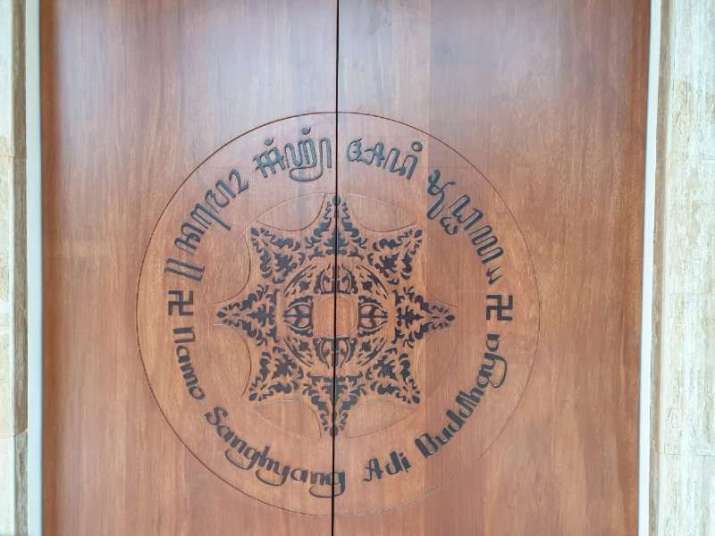
Image courtesy of Dr. Metta Agustina
Perhaps Jinarakkhita’s most distinctive trait was his thorough non-sectarianism. He categorically rejected any hierarchization of Theravada, Mahayana, and Vajrayana—designating them all equally efficacious vehicles to ultimate enlightenment. He also rejected rigid distinctions between the three traditions. As we have seen, he was ordained in both Mahayana and Theravada traditions. Although an accomplished practitioner and teacher of Vipassana meditation, he steadfastly refused to identify himself with any particular tradition. He sought to manifest this non-sectarian approach in his physical presentation, wearing the robes of a Theravada monk but growing out a beard in the tradition of Chan masters. As to his disciples, he would first seek to determine their predispositions before having them ordained as either Theravada or Mahayana monks. The Theravada-inclined would-be monastics were sent to Thailand, while those with a preference for Mahayana were sent to Hong Kong or Singapore for ordination. Upon returning, Jinarakkhita envisioned all of these newly ordained Indonesian monastics being united in a single sangha regardless of sectarian affiliation.
The sangha formed by Jinarakkhita to fulfill this purpose went through a dizzying number of name changes before finally solidifying in 1974 as the Sangha Agung Indonesia—the Supreme Sangha of Indonesia. Almost as soon as this was accomplished, Jinarakkhita’s vision was undermined. Returning monastics from Thailand split with Jinarakkhita’s organization over disagreements pertaining to the Vinaya, forming a purely Theravada sangha. By 1979, Mahayana monks had departed from the Sangha Agung Indonesia, wishing to cleave more closely to the Chinese cultural identity of Mahayana Buddhism. It is, however, a sign of Jinarakkhita’s ubiquitous influence that this separate, purely Mahayana sangha continues to revere him as their founder, and some of the signs of his “Indonesianisation” efforts remain apparent in this latter sangha. For example, the use of Sanskrit and Javanese in chanting and the use of the Borobudur stupa symbol.
Jinarakkhita’s vision of a single, united Sangha was further undermined by the existence of independently founded Buddhist organizations, such as Kasogatan, which sought to revive the indigenous Vajrayana tradition of the pre-Islamic period, as well as the arrival of Buddhist traditions from countries including Thailand, Taiwan, and Japan, which sought to maintain a separate organizational and doctrinal identity from Jinarakkhita’s sangha. The resulting cornucopia of sectarian divisions in Indonesia represents quite the opposite of Jinarakkhita’s original vision. This picture was further complicated by the Indonesian state’s idiosyncratic schema of sectarian categorization. For example, the recognition syncretic Chinese religions as “Buddhist sects” or the categorization of Nichiren Buddhism as separate from Mahayana.
The corporatist ideology of Suharto’s government did, however, inadvertently guarantee some realization of Jinarakkhita’s desire for the organizational unity of all Indonesian Buddhists, albeit in attenuated form. As the state would only recognize a single representative body to speak on behalf of Indonesian Buddhists, the plethora of Buddhism groups active in Indonesia by the beginning of the 1980s were gathered under the organizational umbrella of WALUBI (Perwakilan Umat Buddha Indonesiaor Representatives of Indonesian Buddhists). However, as state corporatism was abandoned after the fall of the Suharto government in 1998, WALUBI experienced a split, with a new organization, PERMABUDHI (Persatuan Umat Buddha or Union of Buddhists), forming in 2018 after an internal dispute. Despite this ultimate failure, Jinarakkhita’s influence continues to be felt in a number of ways: two of Indonesia’s largest Sanghas were founded by his disciples, WALUBI uses the Borobudur stupa as part of its logo, and finally, Sangha Agung Indonesia continues to exist to this day, giving Indonesia the distinction of having a sangha wherein monastics of all three Dharma vehicles are united.
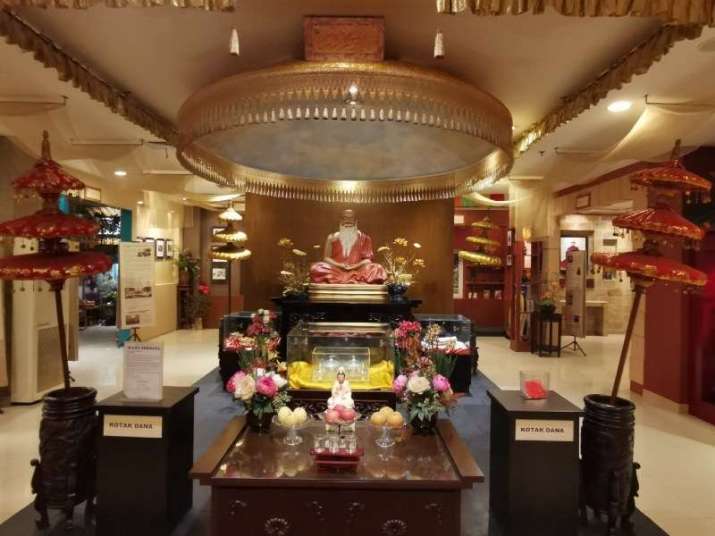
his death with Theravada, Mahayana, and Vajrayana displays. Image courtesy of Dr. Metta Agustina
Mahabhikksu Ashin Jinarakkhita passed from this life on 18 April 2002 while in samadhi. Appropriate to his vision of Buddhist unity, his funeral was conducted with elements from the Theravada, Mahayana, and Vajrayana traditions. In a final act emphasizing the Indonesian-ness of Buddhism, he was cremated at Lampung, near the seat of the historical Buddhist Srivijaya empire.
* For example, Zhen Fo Zong.
References
Jack Meng-Tat Chia. 2018. “Neither Mahāyāna Nor Theravāda: Ashin Jinarakkhita and the Indonesian Buddhayāna Movement.” History of Religions. Vol. 58, Num. 1. 24-63.


